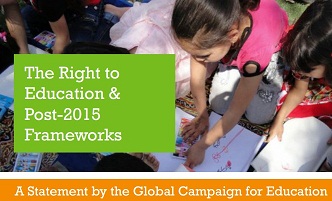Education Saves Lives: Ensuring the Right to Education in the Post-2015 Development Agenda
By Shaharazad Abuel-Ealeh, Global Campaign for Education.
 For every organisation in every sector clamouring to be heard in the frenetic world of the post-2015 development agenda, finding the message that cuts through the noise and is heard – can reap potentially huge rewards. At every opportunity we drive forward with our national and global advocacy efforts, knowing that we are trying to be heard among a cacophony of all those trying to target the key policy makers, but pushing ahead in any case, lest we miss any chance to make our voices heard. With so many competing demands on the profile, priority, language and underlying vision for the new global development agenda, it is vital to articulate both this message and the rational that lies behind it. At the Global Campaign for Education (GCE), it is no different; we have been working with over 100 members in 97 countries worldwide, to ensure the voice of civil society is being heard in the debates on education post-2015, seeking a way to explain our rationale.
For every organisation in every sector clamouring to be heard in the frenetic world of the post-2015 development agenda, finding the message that cuts through the noise and is heard – can reap potentially huge rewards. At every opportunity we drive forward with our national and global advocacy efforts, knowing that we are trying to be heard among a cacophony of all those trying to target the key policy makers, but pushing ahead in any case, lest we miss any chance to make our voices heard. With so many competing demands on the profile, priority, language and underlying vision for the new global development agenda, it is vital to articulate both this message and the rational that lies behind it. At the Global Campaign for Education (GCE), it is no different; we have been working with over 100 members in 97 countries worldwide, to ensure the voice of civil society is being heard in the debates on education post-2015, seeking a way to explain our rationale.
Civil society campaigners in the education sector have much in their favour: a rich history of international commitments and visible progress in meeting some of these targets, and evidence highlighting the critical role education plays in underpinning development more broadly – increasing individual empowerment, strengthening communities and even contributing to the saving lives. The right to education has not only been enshrined in international law since the 1948 Universal Declaration of Human Rights, but states have also continued to reinforce this commitment – in the 1990 Jomtien Declaration and again in the 2000 Dakar Framework for Action on Education For All. To some extent, these commitments have been acted upon: since the formation of the Millennium Development Goals in 2000, tens of millions more children are in school, there has been a fall in the number of non-literate youth and adults, and we’re seeing increased domestic investment in education in many countries.
In many ways, education is a success story: from 2000 to 2011, the enrolment rate grew from 83% to 90%, and the number of out-of-school children dropped by almost 50% – from 102 million in 2000 to 57 million in 2011. Gender parity in primary school enrolments worldwide has been achieved, albeit well after the original deadline of 2005. But behind these headline figures are vast inequalities, and progress is stagnating. There remain serious threats to fulfilling the right to education and honouring the commitment of states to education as fundamental to any development framework beyond 2015.
While overall progress has been made in enrolments since 2000, between 2008 and 2011 the number of out-of-school children of primary age fell by only 3 million. The number of children out of school at both primary and lower secondary level stands at 127 million – and it is estimated that up to a quarter of a billion children who are in the classroom are leaving education without the ability to read or write, even after four years of primary school. Despite the increased enrolments, girls are less likely to complete primary education than boys, and progression to secondary level falls far behind that of boys – to make matters worse, girls are still facing discrimination even when they stay in school.
Aid to education has been dramatically reduced in the wake of the economic crisis faced by almost every donor country, and the challenge to find new donors remains a struggle. A recent GCE report shows that donor governments are currently focusing aid cuts disproportionately on education, with basic education in low-income countries particularly hard hit. At current levels, there remains a total annual gap of $38 billion to achieve basic education[i] and lower secondary education in 46 low-income countries and lower-middle-income countries – this is equivalent to just 2% of the world’s military spending, or 1 month’s revenue for the world’s largest company, Wal-Mart.
 While many governments in low-income countries have made major strides forward in their domestic allocations to education, they are struggling to find replacement funding for withdrawing donors. There is a real and urgent need to increase the domestic financing base for education through the development of fair tax systems, and a GCE briefing on domestic financing outlines, the potentially massive gains to education that could be achieved in this way.
While many governments in low-income countries have made major strides forward in their domestic allocations to education, they are struggling to find replacement funding for withdrawing donors. There is a real and urgent need to increase the domestic financing base for education through the development of fair tax systems, and a GCE briefing on domestic financing outlines, the potentially massive gains to education that could be achieved in this way.
If states meet their obligation to respect, protect and fulfil the right to education, making increased investments, we could all reap huge rewards. Education is not only a fundamental human right, it is also a vital enabling right.
- Improved education is responsible for half of the global reduction in child deaths in the last 40 years, having a far greater impact than economic growth in reducing preventative deaths.[ii]
- Education spreads prosperity and reduces poverty. It is estimated that if all students in low-income countries left school with basic reading skills, then 171 million people could be lifted out of poverty – equivalent to a 12% cut in global poverty. On top of this, each additional year of average schooling can increase GDP by up to 1% per year. An analysis based on data from the International Adult Literacy Survey showed that at the national level, the long run effects of investment in literacy are about three times as important to economic growth as investment.
- High-quality, freely available education improves women’s and girls’ chances of realising their rights. In material terms, women earn more when they are educated: studies suggest that the higher levels of education have greater economic returns for women than men. In India, for instance, a recent study found that the wage benefit for women with secondary education was double that for men.
- Education has a critical role to play in active citizenship and political participation: it empowers individuals, broadens critical thinking and enables them to exercise their citizenship rights. Research in sub-Saharan Africa has shown that voters with a primary education were 1.5 times more likely to support democracy than those with no education; voters who had completed secondary school were three times more likely.
These are not the sole benefits, but they provide a compelling case for ensuring that the right to a quality, public education is realised. Education plays a huge role in enabling many other human rights, and there is clear evidence that education does save lives. This is why GCE believes that there must be a specific goal on education in a global post-2015 development framework alongside the continuation of the Education For All agenda after 2015, and that both must be grounded in a human rights perspective.
The education sector is fortunate that clear and unambiguous commitments to education already exist,, reinforced in international treaties and frameworks and national legislation: what is needed now and beyond 2015 is the global political and financial commitment to improved access, inclusion, quality and equity – the willingness to create the conditions for success to fulfil right to quality education and ensure sustainable development for all.
The Global Campaign for Education (GCE) is a movement bringing together NGOs; teacher unions; child rights activists; parents’ associations; organisations of women, disabled people and other marginalised groups; youth associations; community organisations and other civil society organisations. GCE members include international and regional organisations and networks, and national civil society coalitions in nearly 100 countries.
You can read more on GCE’s work on education in the post-2015 development agenda at:
http://www.campaignforeducation.org/en/campaigns/education-post-2015
Shaharazad Abuel-Ealeh is Head of Communications at the Global Campaign for Education. Email: sherry@campaignforeducation.org
[i] Basic education here refers to three of the six EFA goals related to primary, pre-primary and adult literacy.
[ii] Publicly available censuses and nationally representative surveys of respondents’ educational attainment. This data was used to investigate the relation between child mortality and educational attainment among women of reproductive age (15-44 years) over time at the country level, using a model including other major determinants of child mortality that are not on the pathway between women’s education and child health -namely, income per person and HIV seroprevalence.

Pingback : Education Post-2015: Recurring Themes | NORRAG NEWSBite